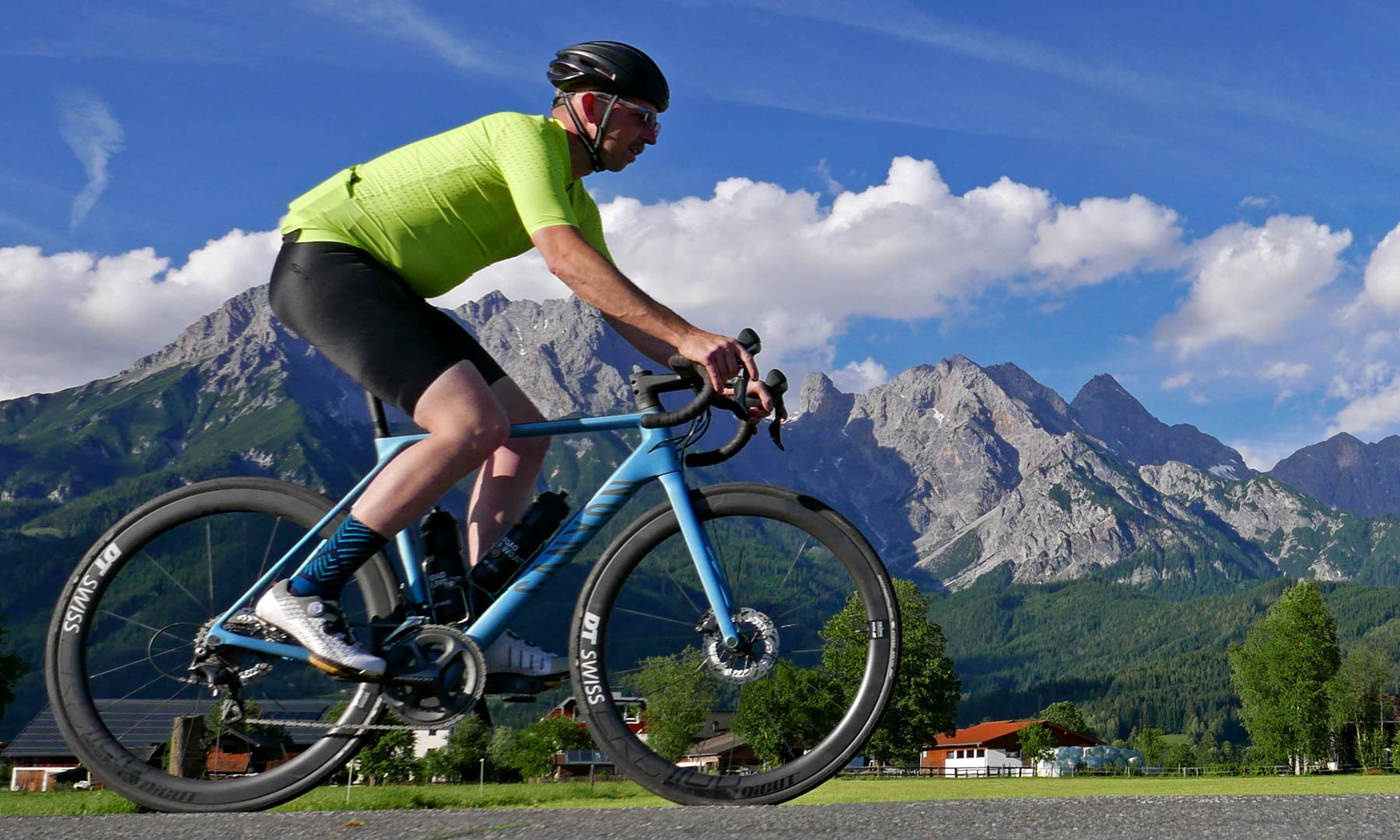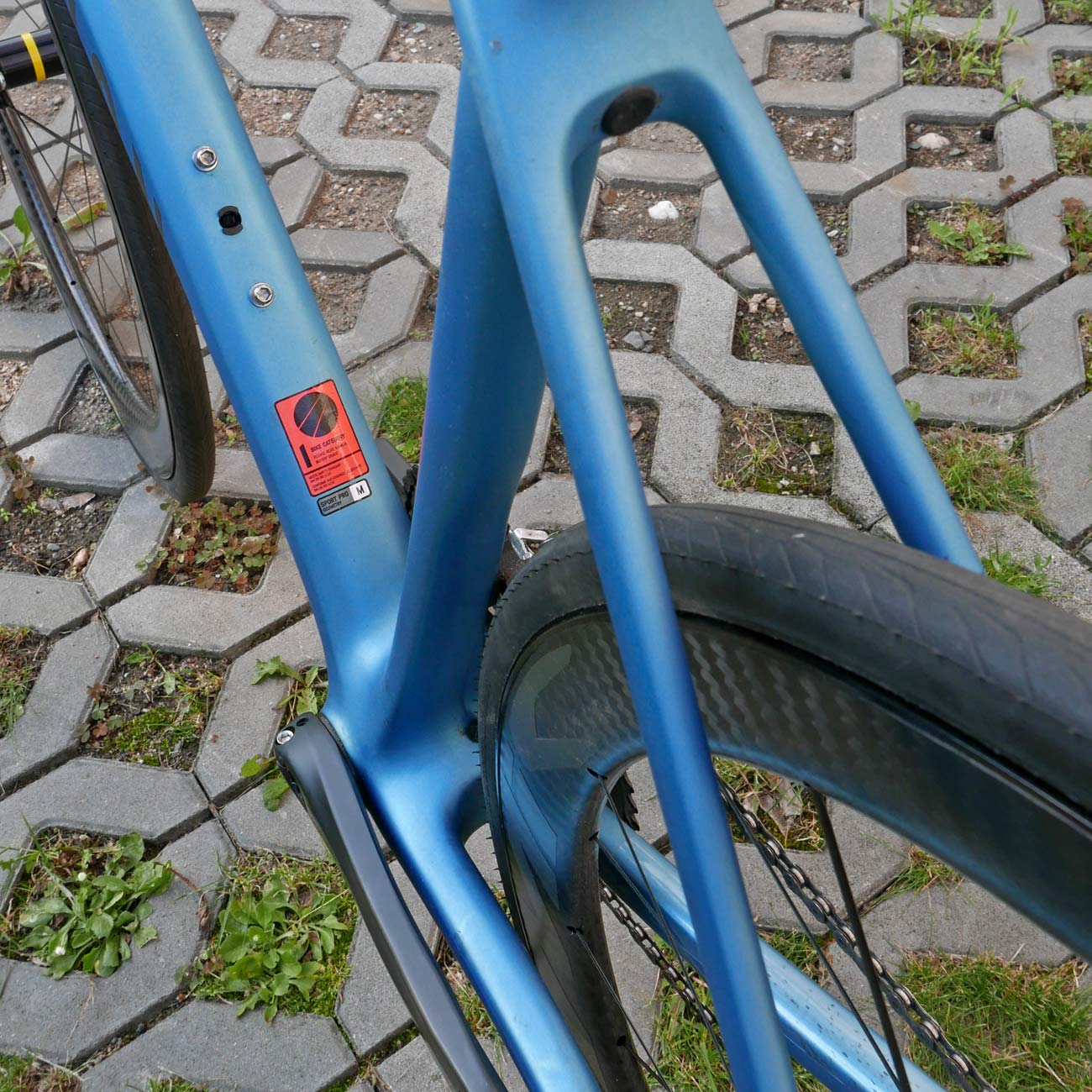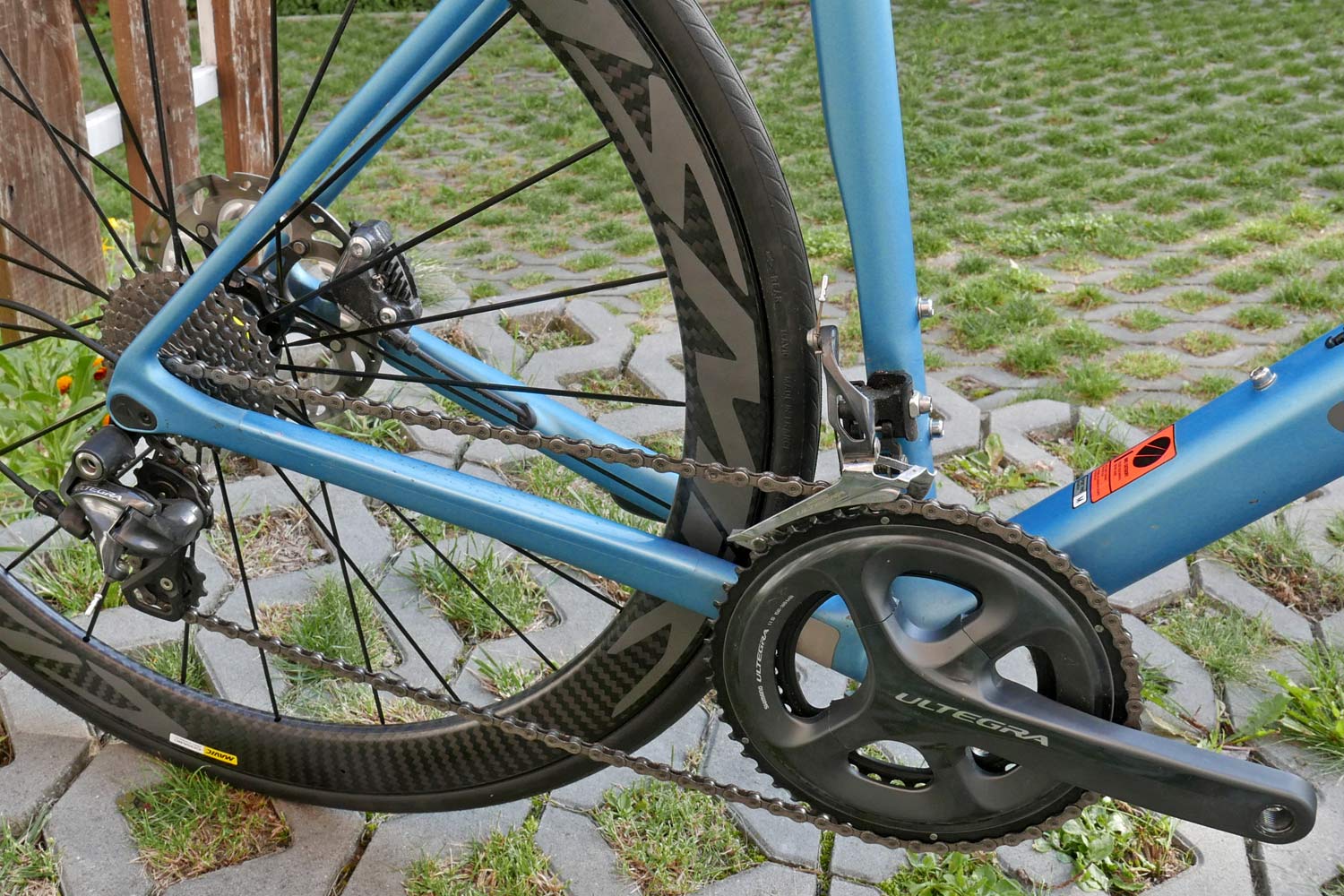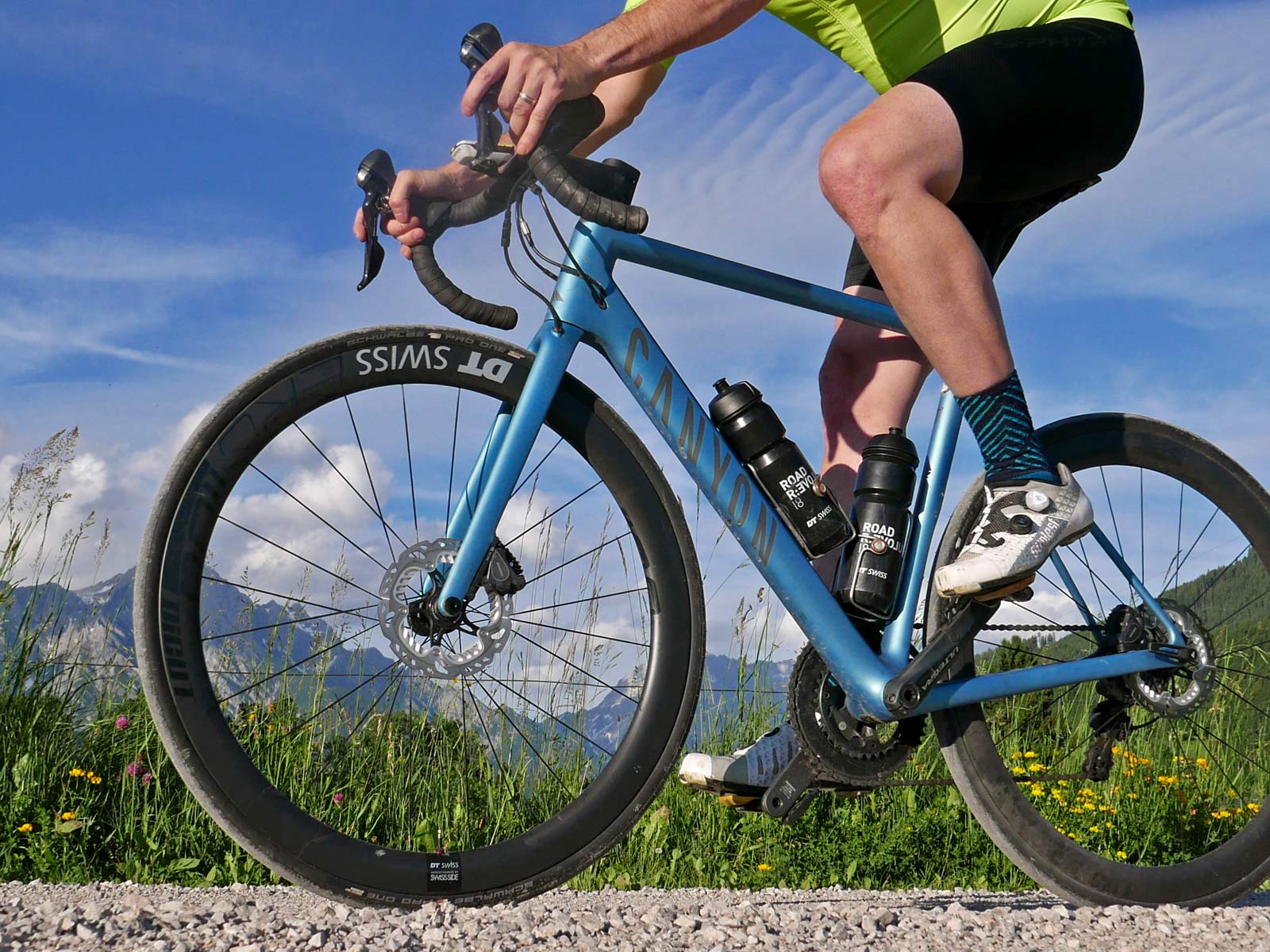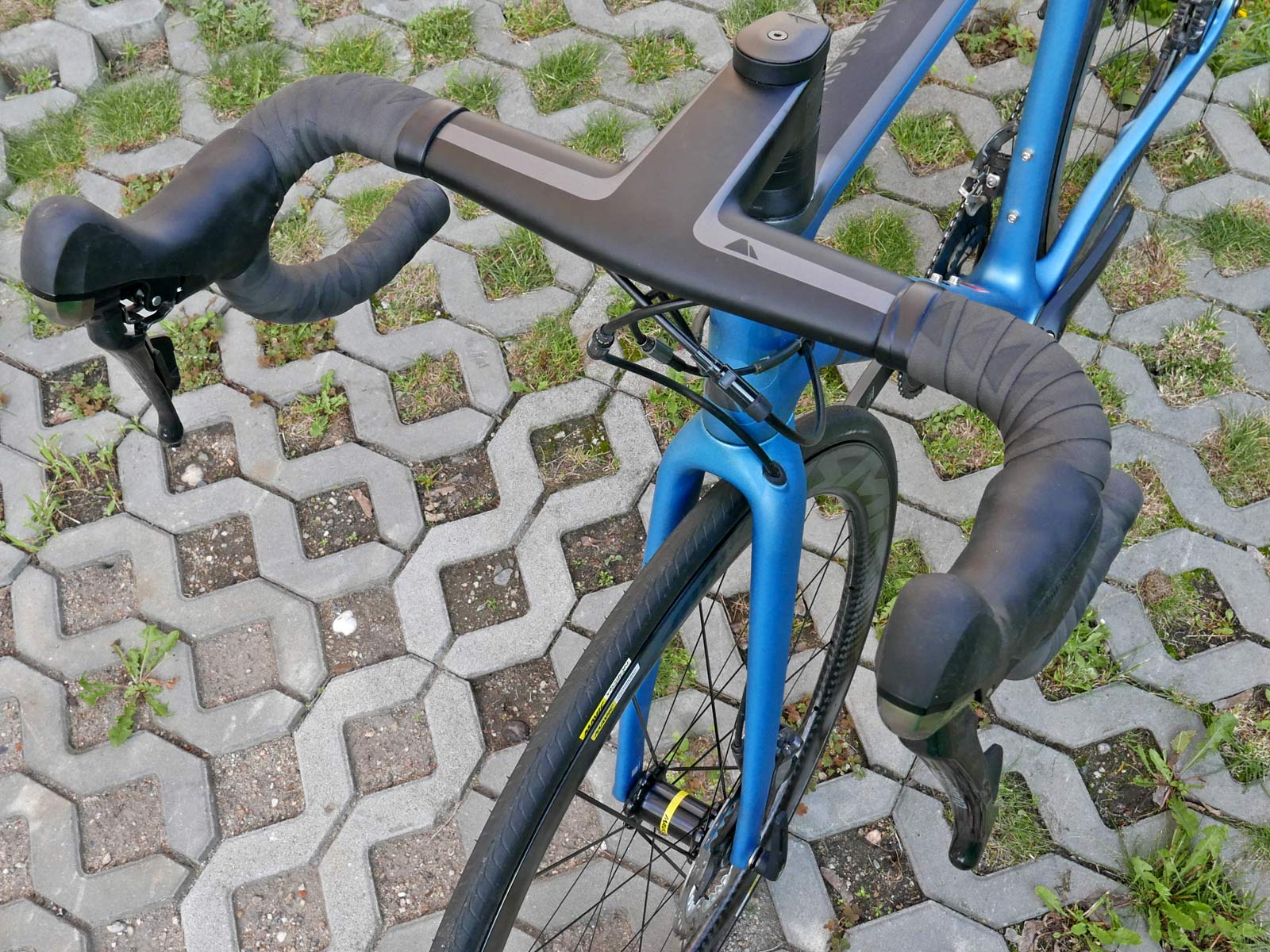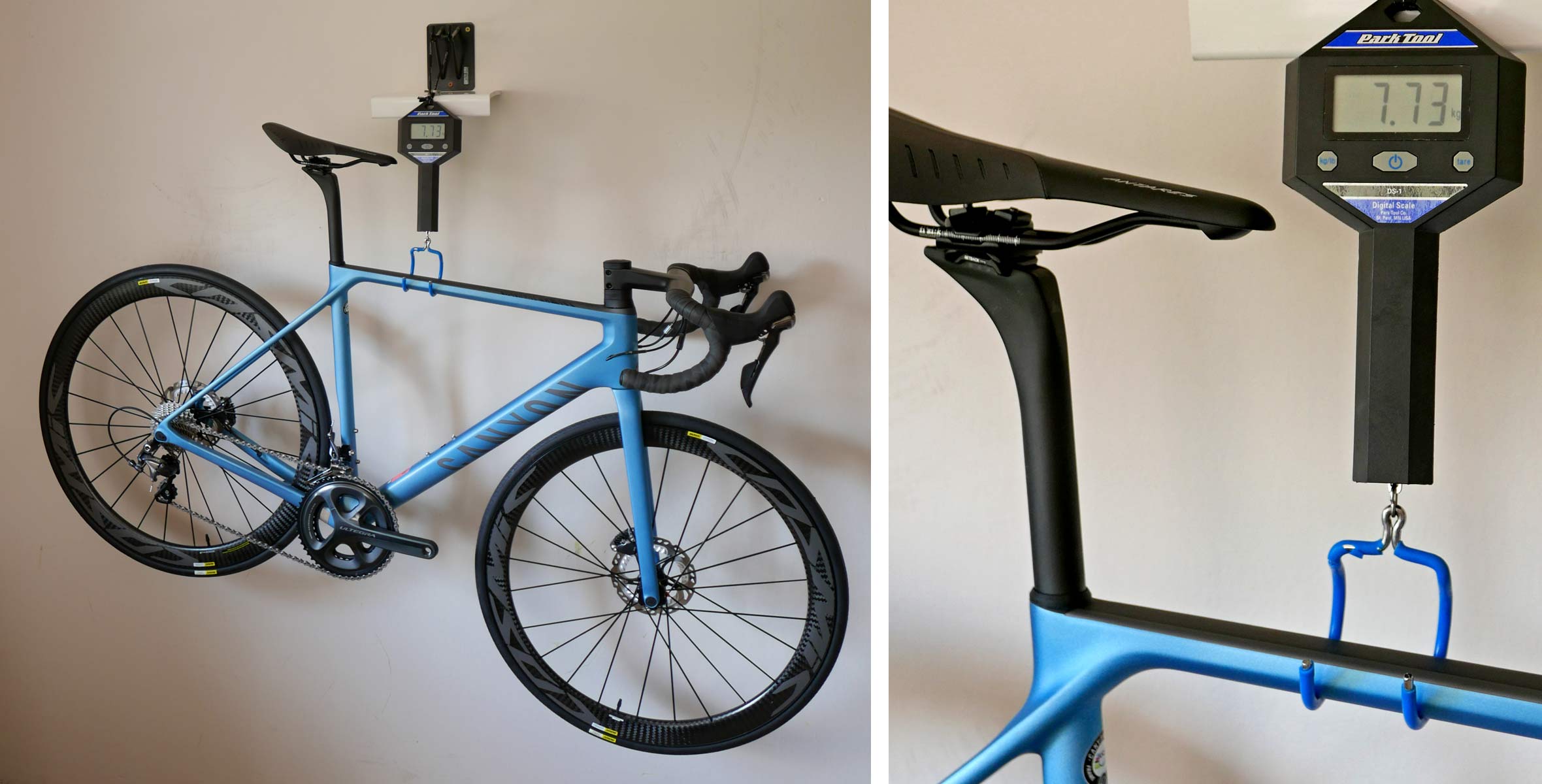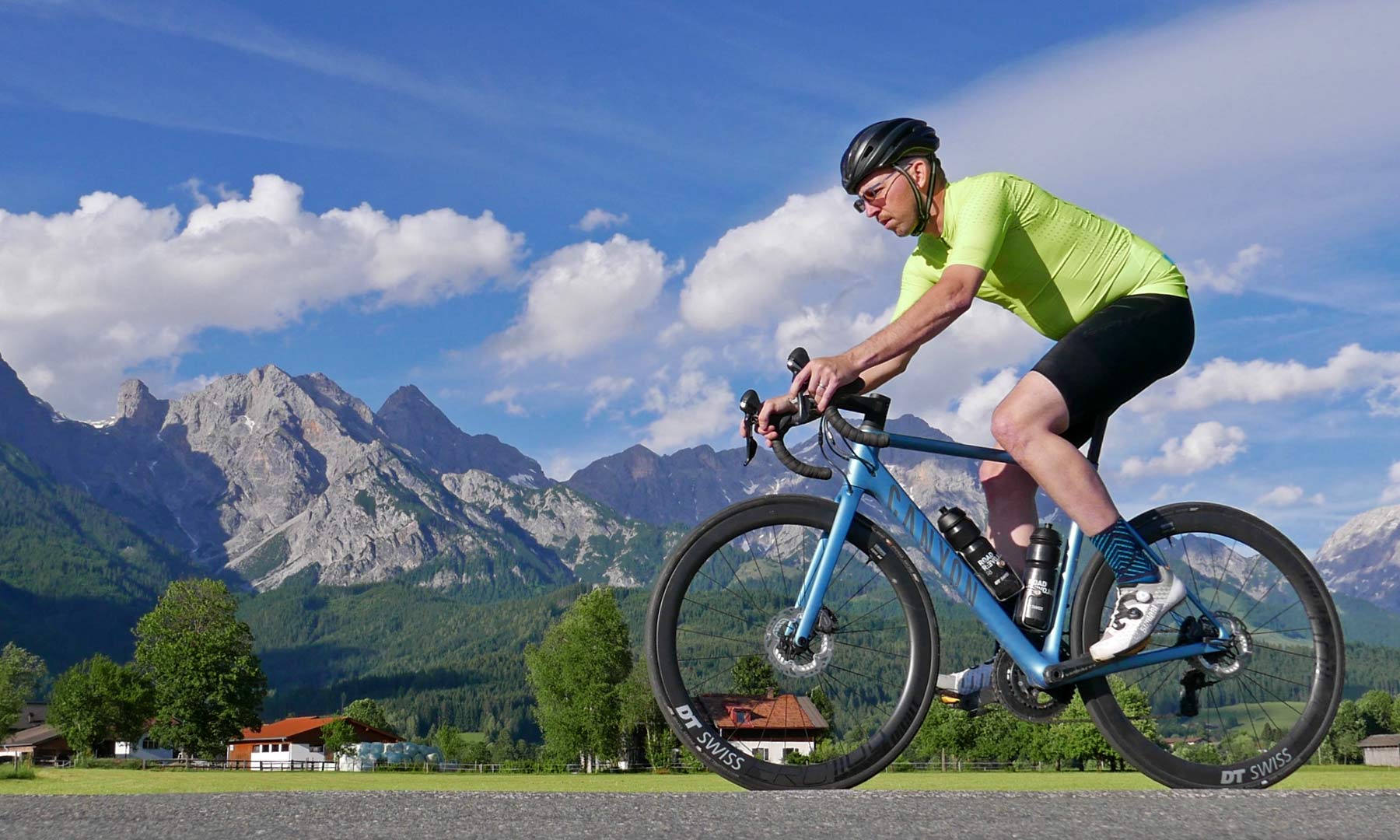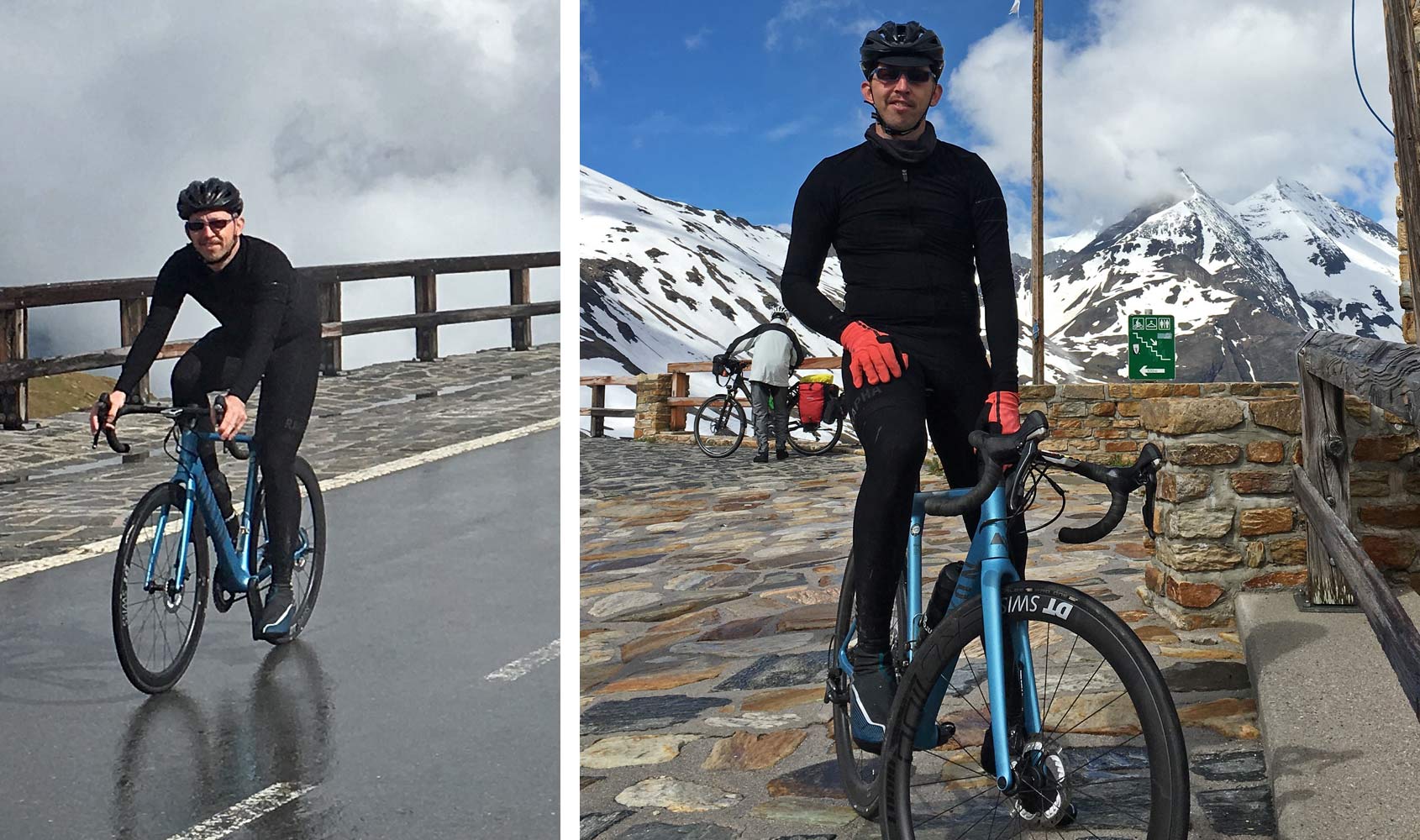First officially unveiled at Eurobike back in 2016, Canyon’s disc brake version of their Ultimate carbon road bike slots in extra space for wider tires along with improved braking for the lightweight race bike. True to its name, there is a lot to like with the fast, yet comfortable bike that we rode up mountains and over a mix of road surfaces.
Canyon Ultimate CF SLX Disc 8.0 carbon road bike
On the surface the Canyon Ultimate CF SLX Disc is a light carbon race bike, but with modern axle and braking standards, coupled with room for large volume road racing tires, it becomes even more versatile. With the same top-level SLX carbon tech as used in Canyon’s premier World Tour winning road bikes, the Ultimate CF SLX Disc is light at a claimed 820g for this size M. It also features quick handling geometry that Canyon classifies as Sport Pro, with a 73.3° headtube, 73.8° seattube & relatively compact 415mm chainstays on our test bike.
Canyon’s consumer-direct delivery method also packs in a lot of value. At 4200€ as tested, the Ultimate CF SLX Disc 8.0 is still a lot of money, but you get a lot for your euros, with a full Shimano Ultegra mechanical groupset including Shimano’s reliable hydraulic disc brakes. (The currently available bike features the newer R8000 version of the groupset.) This bike build also includes a set of mid-depth 45mm carbon Mavic Cosmic Pro Carbon disc wheels and Canyon’s own premium one-piece carbon integrated bar+stem H36 Aerocockpit.
We rode the Ultimate CF SLX Disc like an all-arounder for the several months that we tested it, riding up long Alpine passes, over rolling hills across central Europe, and on a fair share of rougher old cobblestone & hardpack gravel roads. One of the big claims of this version of the Ultimate is a 15% increase in comfort over the previous rim brake version, so we wanted to see if that Canyon delivered without losing its snappy race-ready feel.
Tech Details
A first look at the rear end of the bike gives clues as to where that comfort will come from. With the move to a full-carbon 12mm thru-axle rear dropout and dropping the unnecessary brake bridge, the bike ends up with a spindly set of long seatstays, reactively wide-set and hitting the seattube below the top tube. The seattube itself gets a rear wheel cutout, although it seems less about adding tire clearance and more about allowing the lower portion of the seattube to flex for a bit more rider comfort. The Ultimate retains decent sized chainstays, but they are still not the overly boxy shape we commonly find on many light carbon race bikes.
That layout derived from more endurance-oriented bikes works quite well here to provide plenty of room for larger tires (up top) which go a long way to improving ride comfort and grip. The other big thing to notice from the back is the dropped seatpost clamping mechanism. That small rubber grommet in between the seatstays is actually a plug stuck into the clamp’s bolt. By dropping the clamp down an extra 4cm or so, the bike allows more effective extension of the 27.2mm carbon seatpost (Canyon’s own post with vibration VCLS damping tech) so that it can flex and eat up some more vibration.
I personally get annoyed at almost every ‘alternative’ seatpost clamping mechanism for one reason or another. This solution bugged me because one: it was constantly being showered in road spray off the rear tire, two: I was sure I would lose the little rubber plug (note over a few moths I did NOT lose it in the end), and most importantly three: positioned tightly in between the stays I could maybe get 1/4 rotation of the bolt at a time with a shop L-shaped allen wrench, and even less than that with a mini-tool out on a ride. In reality, after one adjustment after the initial setup, I never had to touch it again. The seatpost stayed in place, so the bolt location never amounted to more than an initial annoyance.
There are a couple other points worth noting when looking at the bike from this angle. You can see that this frame still includes some old-school external battery Di2 routing in between bottle bosses on the downtube. Behind the pressfit BB92 bottom bracket there is a pretty large chain stay bridge/shelf where the front derailleur wire is routed up from under the BB. While riding on wet roads that cable got doused with spray, and I suspect if you ride this bike a lot in wet conditions, you are going to have to regularly clean & replace that shift wire. 415mm stays aren’t super short for a road race bike, and you can see there is a lot of room above the stock 25mm tire. There isn’t huge side clearance, but we had a comfortable amount of room while running 28mm Schwalbe Pro One tires tubeless on the wider 19mm internal DT Swiss ERC 1100 wheels.
In those extended chainstays you get full internal cable routing, and flat mount disc brakes. Looking to the drivetrain build, it’s no-nonsense with excellent performing Ultegra mechanical and a mid-compact 52/36 chainset paired to a standard road 11-28T cassette (and short cage rear derailleur). While that might have been tough gearing for me in the Alpine climbs on a heavier bike, it remained just wide enough to get me over the passes. That gearing is probably best suited for most riders on rolling terrain. Even though it was fine for a weekend trip to the mountains, if I spent more time there climbing I would have wanted to go compact, and probably moved up to my standard 11-32T cassette setup.
Up front the Ultimate gets a thin set of fork legs, a 12mm thru-axle, a flat mount disc brake, and an integrated one-piece bar & stem.
You’ll also notice that most of the riding pics show the bike with the non-stock DT Swiss ERC 1100 wheels and Schwalbe Pro One tires or various widths (we fit 23, 25 & 28mm tires over the course of the test.) The stock Mavic Cosmic carbon wheels were not tubeless ready. And with their 17mm internal width the accompanying 25mm Yksion tires were too low volume and too stiff for our liking, requiring more pressure than we prefer for the rough roads surfaces we regularly encounter. The wheels are the only item of the complete spec that we disliked, and the swap to a wider tubeless wheel setup made a noticeable improvement to the comfort and cornering of the bike, not to mention the mental boost of not worrying about flats and getting a free rolling resistance boost.
Up front the Ultimate is dominated by Canyon’s aero carbon H36 Aerocockpit bar & stem combo. Scaled to match frame sizing, our medium test bike came with an effective 100mm stem length and a 41cm (center to center) bar width. That’s more narrow than I would almost ever ride, and again locked into the size I was bit concerned about fit. With test bikes, we can usually get a couple of riders by swapping stems, but this setup fit me so for the most part it was I who spent time on the bike.
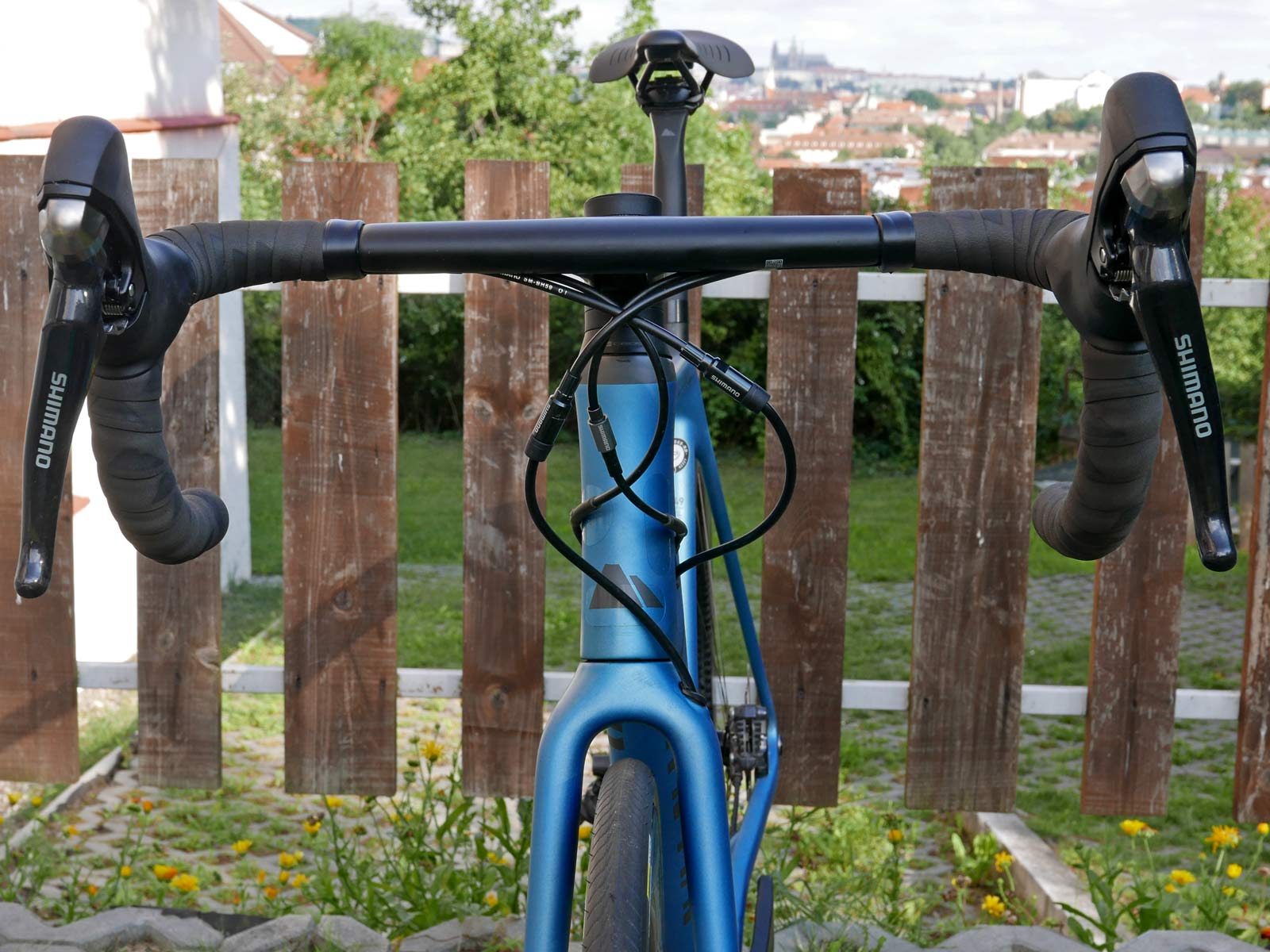 A look from the front shows the relatively slim profile of the bike. While it isn’t Canyon’s aero road frame, the Ultimate does get a fair share of aero optimized tube shaping, plus as small frontal area as possible.
A look from the front shows the relatively slim profile of the bike. While it isn’t Canyon’s aero road frame, the Ultimate does get a fair share of aero optimized tube shaping, plus as small frontal area as possible.
Like at the rear end the stock wheels and 25mm tire reveal plenty of space to fit much larger, high-volume road tires.
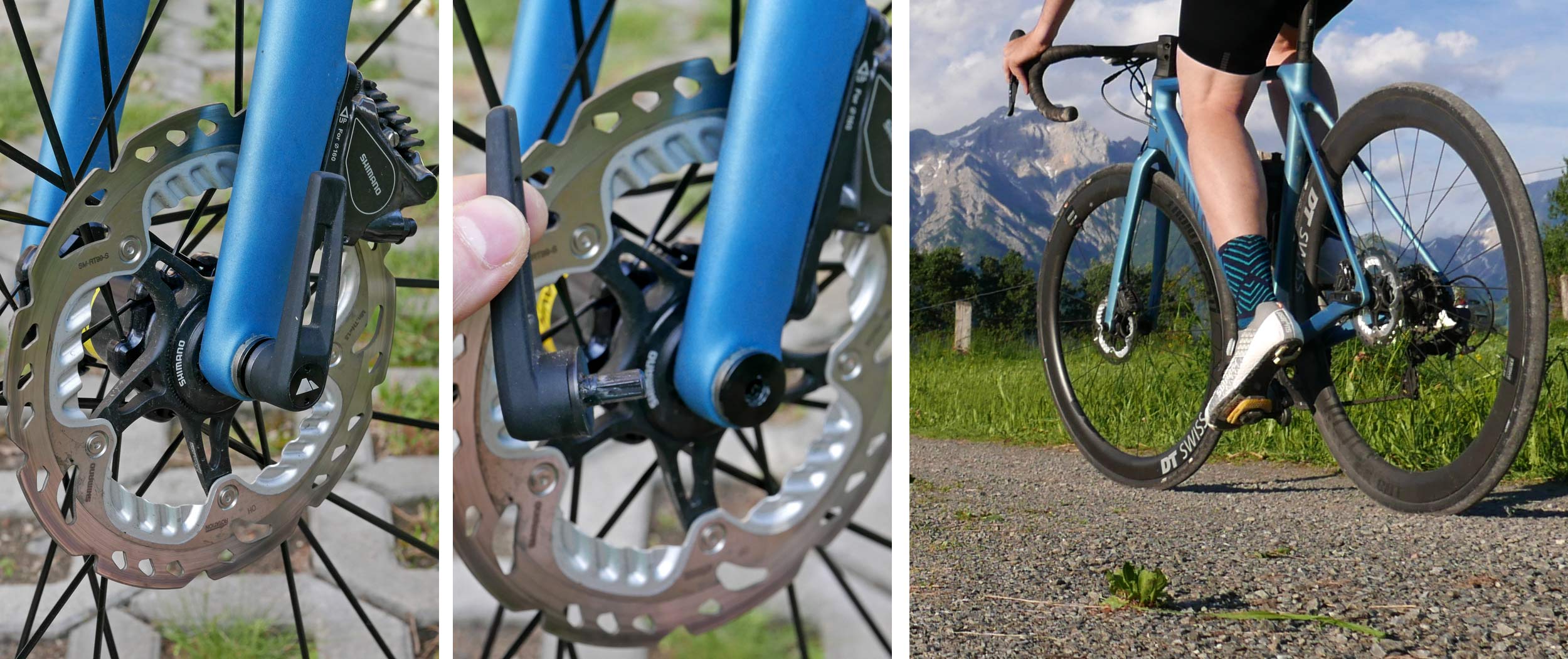 Another nice feature of the 12mm thru-axle setup from and rear is the use of a single, removable RWS lever. Using a slightly customized version of DT Swiss’s RWS Plug detachable quick release lever, Canyon lets you use tighten both wheels with one universal lever, then keep it attached to the rear wheel (where it stayed securely for the duration of our test riding), or pop it in your pocket for the most aero solution. Even if you leave it at home, a standard 6mm allen wrench will tighten & loosen the axles.
Another nice feature of the 12mm thru-axle setup from and rear is the use of a single, removable RWS lever. Using a slightly customized version of DT Swiss’s RWS Plug detachable quick release lever, Canyon lets you use tighten both wheels with one universal lever, then keep it attached to the rear wheel (where it stayed securely for the duration of our test riding), or pop it in your pocket for the most aero solution. Even if you leave it at home, a standard 6mm allen wrench will tighten & loosen the axles.
Overall complete weight for the medium sized Canyon Ultimate CF SLX Disc 8.0 was 7.73kg/17.0lb on our scale, stock with the Ultegra build & Mavic wheels (no pedals). Swapping on the wider DT wheels and wider, but tubeless Schwalbe tires only saved around 150g overall, but made a big improvement in overall ride quality.
Setup & Ride Review
Part of the challenge of buying a premium bike from Canyon is committing to your order and then sending your hard-earned money into the ether of the internet after studying the spec & geometry charts to pick what is best for you. That’s what we had to do too.
I did the math, added up and compared frame reach figures and stem lengths with my personal & recent road bikes, and came away thinking that I would need a Medium bike (even though I stand a bit taller at 185cm/6’1″). Stack was a bit more flexible, and I could move the saddle around. But the bar reach was going to be fixed.
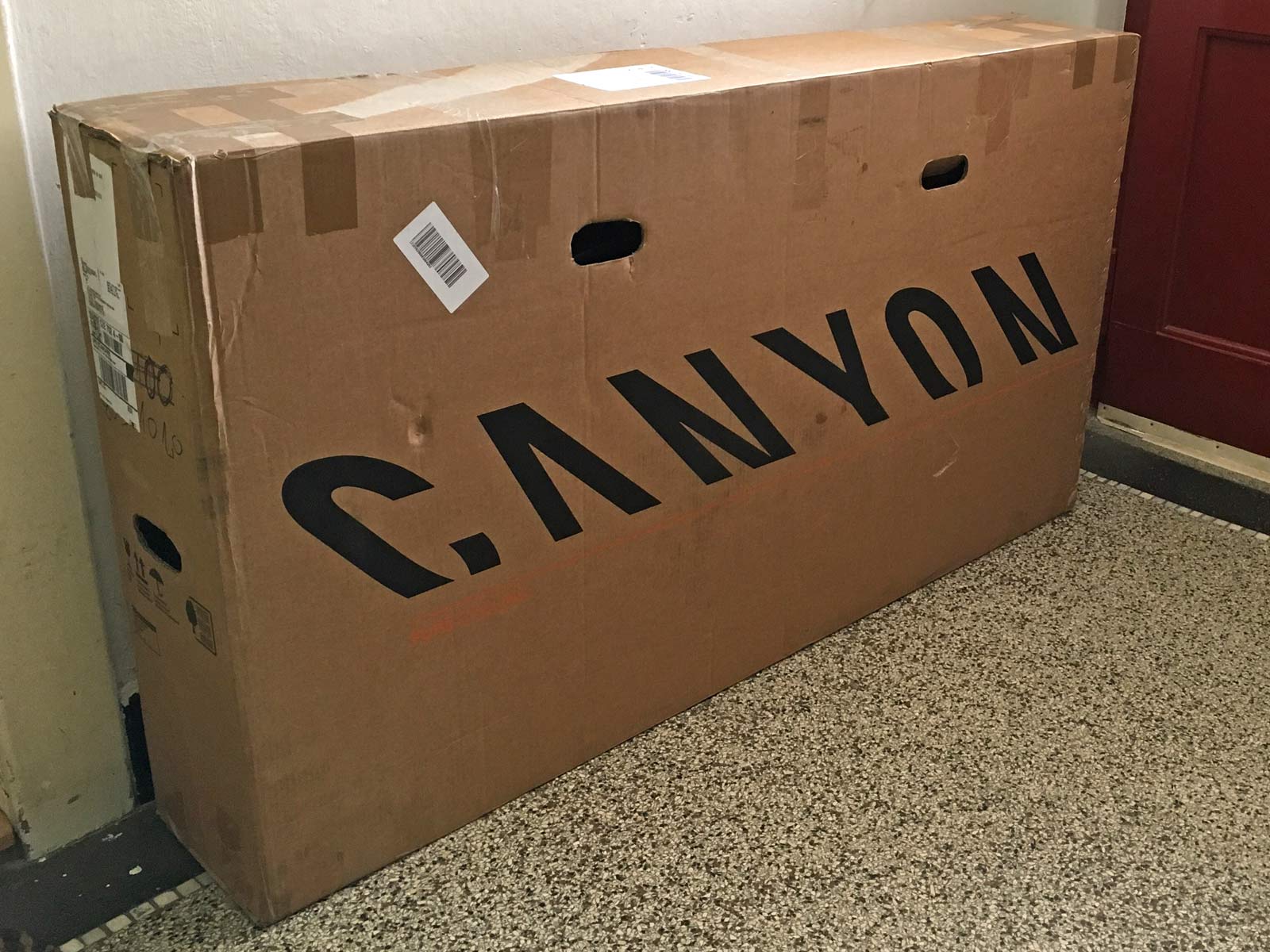 So I ordered, and a couple days later a mysterious Canyon bike box appeared at my door. Anyone (like myself) who has spent time working as a wrench in a bike shop, both dreads and looks forward to opening one of these boxes. Inside there is usually a lot of work to do, but also the promise of a new ride.
So I ordered, and a couple days later a mysterious Canyon bike box appeared at my door. Anyone (like myself) who has spent time working as a wrench in a bike shop, both dreads and looks forward to opening one of these boxes. Inside there is usually a lot of work to do, but also the promise of a new ride.
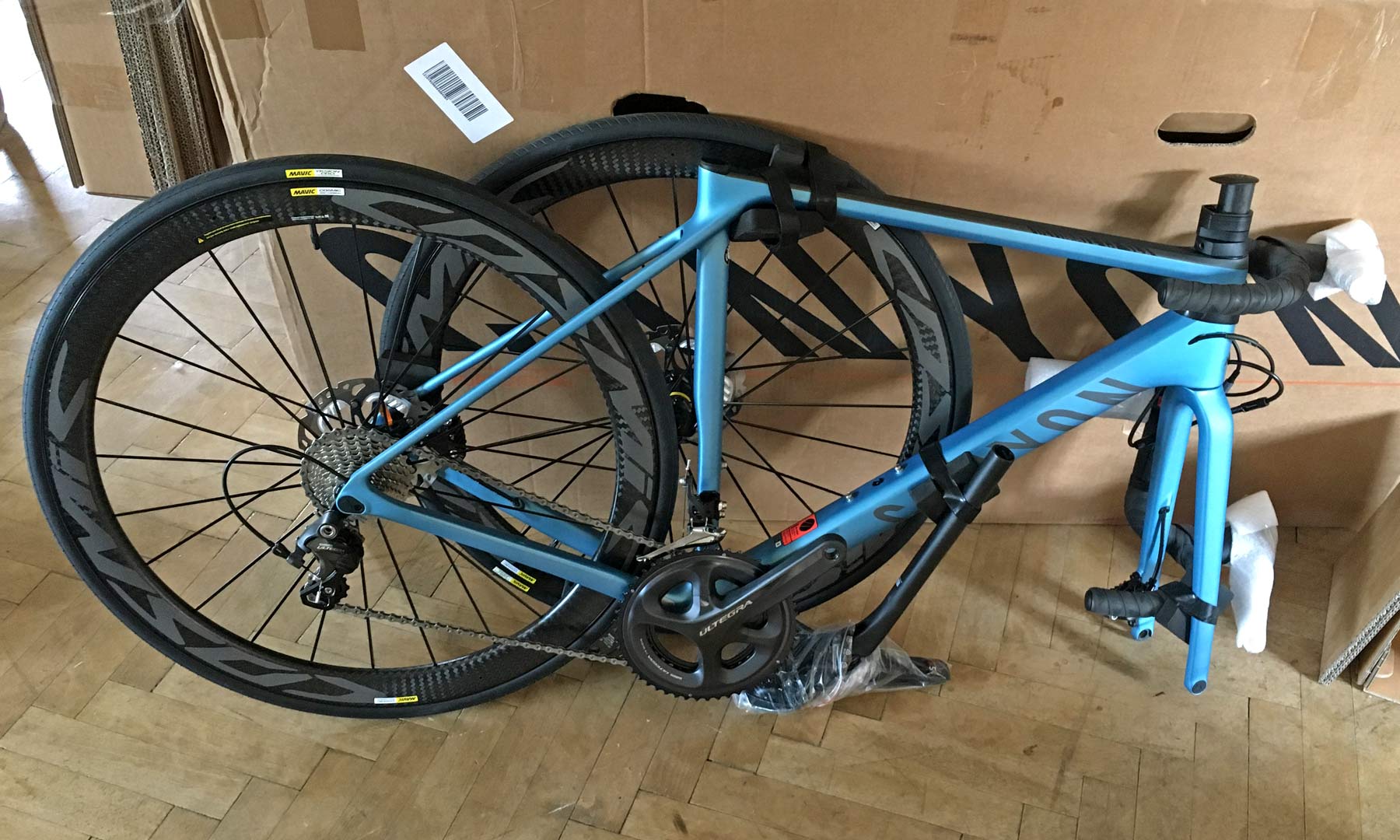 In fact, Canyon has put a lot of development into making the unboxing to ridable bike transition quick and easy. A bunch of velcro straps held the loose bits in place, but the bike packing is well done, and the bike is for the most part already setup.
In fact, Canyon has put a lot of development into making the unboxing to ridable bike transition quick and easy. A bunch of velcro straps held the loose bits in place, but the bike packing is well done, and the bike is for the most part already setup.
All I had to do was put the front wheel in (and tighten the axle), then drop the seatpost into place & tighten (after measuring my seat height), then pop on the combo bar+stem & tighten, and thread in some pedals. Nothing overly complicated and Canyon includes a basic beam-style torque wrench to ensure everything is installed to spec.
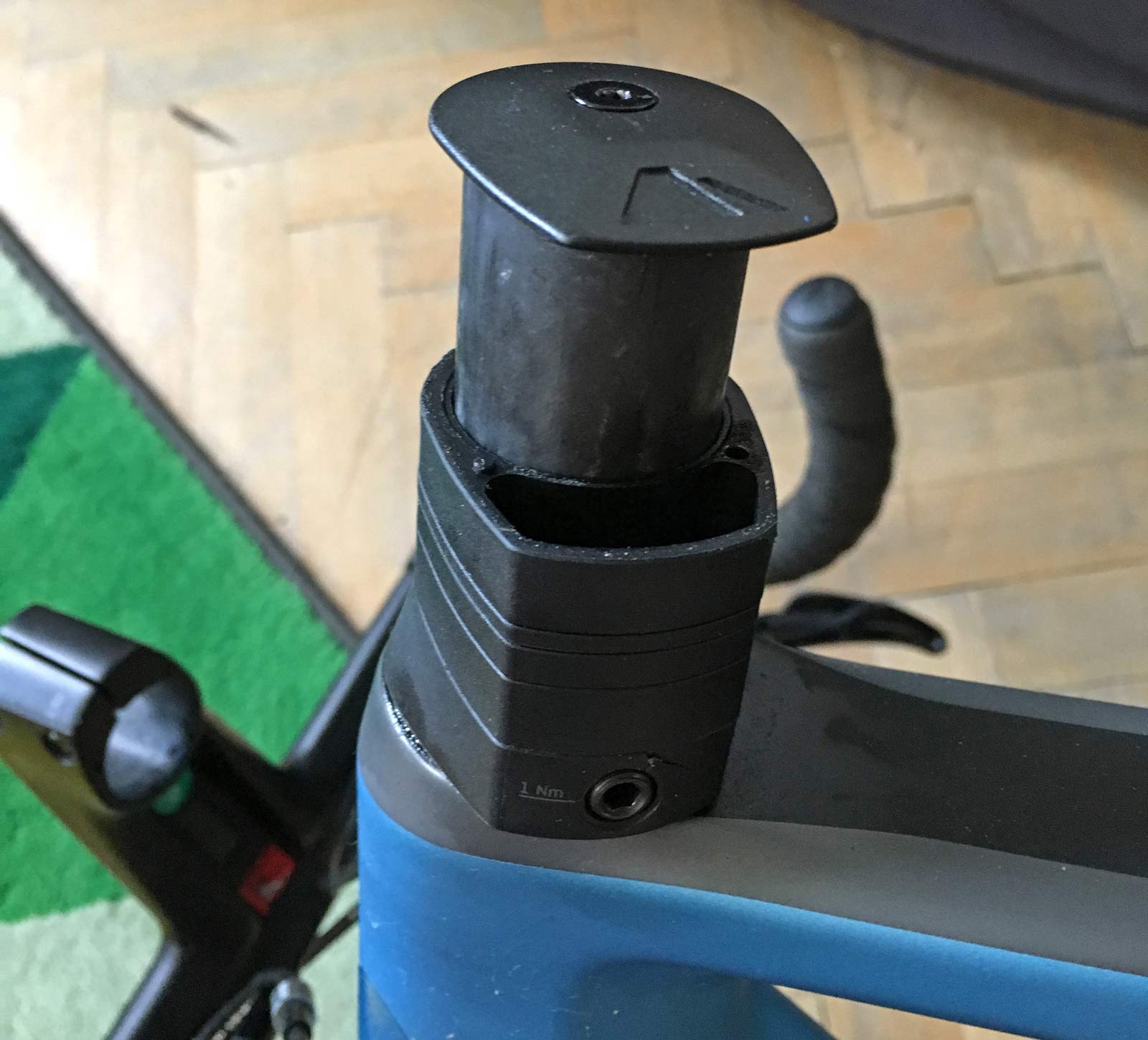 The only problem I had with setup was moving around the headtube spacers to dial my fit. Canyon uses a series of composite spacers, with the lowest one featuring a small set screw to keep the fork from dropping out of the bike when the stem is not attached.
The only problem I had with setup was moving around the headtube spacers to dial my fit. Canyon uses a series of composite spacers, with the lowest one featuring a small set screw to keep the fork from dropping out of the bike when the stem is not attached.
I wanted to move that spacer and when tightening it back, I overtorqued its 1Nm limit. Word of advice, 1Nm is almost nothing & many torque wrenches have no resolution that low. (It is pretty much just finger tight with no tool leverage. The piece is no structural, and entirely inexpensive (and the damage was 100% my fault.) But it brings up the Canyon conundrum – if something small (& especially proprietary) like this is damaged, you can’t pop down to the local Canyon dealer. Instead you go back online, send a repair or replacement item request via the website, and then wait for Canyon to send out the replacement part.
With all of those details said that turned up over the course of several months riding the bike, the Ultimate CF SLX Disc delivered on being a racy road bike I could ride everyday. Once I swapped to tires measuring a real 27-28mm (and set up tubeless), I rode the bike for urban commutes on Prague’s rough cobblestone streets. I rode it after work on the rough asphalt roads that surround the city. And I took the bike to cover a mix of hardpack dirt & gravel roads that tied together plenty of scenic rolling paved roads on the weekends. I even took the bike into the Alps a couple of times for some extended climbing (and descending) in both dry and wet conditions.
The thin rear end delivered on enough comfort that I never felt beat up on the bike. The hydraulic disc braking was top-notch and repeatedly rewarded me on long & twisty downhills with a smile on my face and a few personal best DH KOMs. Riding in rain or shine, and on smooth asphalt or loose roads, both handling & braking were consistent and predictable in a way that made me want to ride more and ride fast.
As much as the rear of the bike was forgiving, I was pleasantly surprised that the thin fork legs and (stiff) narrow bar worked well together to provide agile steering without ending up with sore shoulders are several hour long rides.
Final Thoughts
A lot of times I’m sad to see a test bike go back home, and the Ultimate CF SLX Disc was a good example of this. The high-end frameset didn’t have a lot of premier kit on it (besides maybe that one-piece carbon cockpit, and the DT wheels that got put onto another test bike), but its ride was refined.
To me this is what a proper road bike should aspire to be these days – light but not crazy light, steep racing-inspired angles and thru-axles for precise handling, disc brakes for reliable & modulated stopping, and enough room to run 28-30mm road tires set up tubeless (I really have no desire to ever ride a tire smaller than 27mm again for any reason, after feeling the comfort & grip improvements in modern road tires.)
I’ve ridden a number of aero bikes that feel faster, and superlight bikes that carry me up the hills more quickly. But only one or two other road bikes I’ve ridden in the last several years have felt as well-rounded as the Ultimate. I certainly got used to having this Canyon in the quiver for the time it was around, and I never had to look hard for motivation to get out and ride any type of road I could think of.
